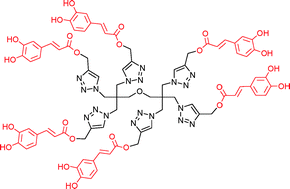Caffeoyl and cinnamoylclusters with anti-inflammatory and anti-cancer effects. Synthesis and structure–activity relationship
Abstract
The syntheses of twelve

* Corresponding authors
a
Department of Chemistry and Biochemistry, Université de Moncton, Moncton, Canada
E-mail:
mohamed.touaibia@umoncton.ca
Fax: +1 506 858 4541
Tel: +1 506 858 4493
b Centre de Recherche en Rhumatologie et Immunologie and Faculté de Médecine, Université Laval, Québec, Canada QC
The syntheses of twelve

 Please wait while we load your content...
Something went wrong. Try again?
Please wait while we load your content...
Something went wrong. Try again?
L. H. Boudreau, N. Picot, J. Doiron, B. Villebonnet, M. E. Surette, G. A. Robichaud and M. Touaibia, New J. Chem., 2009, 33, 1932 DOI: 10.1039/B907878A
To request permission to reproduce material from this article, please go to the Copyright Clearance Center request page.
If you are an author contributing to an RSC publication, you do not need to request permission provided correct acknowledgement is given.
If you are the author of this article, you do not need to request permission to reproduce figures and diagrams provided correct acknowledgement is given. If you want to reproduce the whole article in a third-party publication (excluding your thesis/dissertation for which permission is not required) please go to the Copyright Clearance Center request page.
Read more about how to correctly acknowledge RSC content.
 Fetching data from CrossRef.
Fetching data from CrossRef.
This may take some time to load.
Loading related content
